![]()
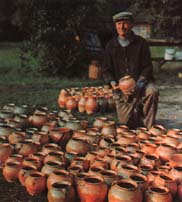 Belarusian
Pottery
Belarusian
Pottery
Pottery is one of the most ancient crafts on Earth. It was practiced in
the lands which are currently known as Belarus from the pre-historic times. The slavic
tribes has started to settle here since VII century assimilating baltic tribes that were
populating these lands before - Yatviangians, Lits etc. Thus Belarusian ceramic tradition is
Slavic and Baltic in its origin. The potter's wheel has appeared in our lands in X
century. Before it all ceramics was hand plastered. Hand plastering technique has
survived in Paniamonnie (Litvanian lands in the basin of the Nioman river) to these days.
|
During the days of Kievan Rus' (X-XII cc.) the main centers of ceramic crafts were ancient Belarusian cities of Polacak, Turau, Smaliensk principalities and the towns of Paniamonnie. Later in XIII-XVII cc Belarusian lands were in the heart of the Grand Duchy of Lithuania, Rus' and Samojitia (GDL). Numerous craftsmanships have flourished in GDL. It is at this time the belarusian ceramic craft is reaching its heights. Belarus begins to export ceramics abroad to Moscow, Warsaw, Kyiv. Many belarusian craftsmen were captured and forced to move to Muscovy during its XVII c. wars with GDL. Such Pokrovski Cathedral in Izmajlovo, Nadbramnaia Church in Andreevski Monastery, Teremnoj Palace and the Savior Church behind the Golden Fence of Moscow Kremlin are all decorated by belarusian craftsmen. The most known centers of ceramic craftsmanship at this time were Hrodna, Streshyn, Biarescie, Miensk, Polacak, Kamianec, Kapyl', Mir, Shklow, Slucak, Klecak, Viciebsk, Dzisna, Krychau, Kopys', Kreva, Mahilyow, Lahojsk, Dubrouna. In XVIII-XiX cc. Belarusian Ceramic Tiles (Kaflia) were famous a long way from Belarus and deserve a special page. In XIX c. - beginning of XX c. the most known centers of ceramics were in Babinavichy, Babrujsk, Barysau, Blahauka, Viciebsk, Hlybokae, Horki, Darasino, Dzisna, Dubrouna, Ivianiec, Kasciukovichy, Kopys', Krychau, Kreva, Licvinavichy, Mahilyow, Miensk, Mir, Pahost-Zaharodski, Porazava, Rakau, Ruzhany, Siniauka, Chashniki, Ekiman', etc. The largest centers were Haradnaia and Pruzhany - each having more than 200 masters. At these time about 4,500 ceramic masters worked in Belarus. After 1930 independent ceramic craftsmen were considered by communists as an "embryo of capitalism" and were either united into state enterprises or extinct. Currently the main state enterprise in Belarus is consortium "Belaruskaia Mastackaia Keramika". The main centers where traditional ceramic craft has survived are: Haradnaia (Stolin region), Drybin (Horki region), Novae Vil'ianova (Shklow region), Porazava (Svislach region), Ruzhany (Pruzhany region) and the town of Braslau. The most sophisticated ceramic tradition is known to be in Southern Belarus and has in
fact much in common with Valyn' (Ukraine) ceramic tradition. On the contrary, in the
Northern Belarus more archaic traditions have survived sometimes dating as far as Iron
Age. Very often the whole village is specialized traditionally in ceramics of a special
type. And thus different types of ceramics are often named by the name of the village
where it is traditionally made - "Haradnianskaya", "Ivianeckaia",
"Rakauskaia", "Chashnickaia", "Siniauskaia",
"Ruzhanskaia", "Pruzhanskaia", "Porazauskaia",
"Mirskaia", "Zaslauskaia", "Doobrovenskaia",
"Dzisenskaia", "Darasinskaia", etc. The main types of ceramic vessels made in Belarus were the following. "Sparysh" - is a double or triple pot of the same or different size with one big handle on top. They were used to bring the meal into the field to working peasants during the day. "Sloi" or "sloik" is a big tall pot with a wide mouth designed to be covered with cover or wrapped on top. These were the ancient jars up to 20Liters in volume. They were used to store grain, marinate and pickle vegetables and mushrooms, store milk and sour cream. They were usually made as "palivanaia" ceramics. Salt was traditionally stored in wooden "sloiks" - "sal'nicy". "Miska" - is a deep ceramic (or wooden) plate used to eat food from. It is one of the oldest forms of ceramic products known from "Bronze Age" on the territory of Belarus. The most typical were made as "palivanaia" and "chorna-zadymlenaia" ceramics. They were normally strongly decorated. "Makacer" - has its name from one of its original functions - grinding poppy seed. It is a low pot with narrow base and wide mouth. It had different versions - "na mak" had a fine grid made by a sharp stick on the inside surface before firing it in the furnace. This grid helped to grind poppy seed or hemp seed to extract hemp oil. "Makacer na bliny" had two handles and was used to prepare mix for pancakes and bread. They were prepared out of heat-resistant ceramics to bake things in the oven. "Harshok"- is taller than "makacer" and has less wide mouth. This is the main ceramic container used in cooking. Most of the Belarusian food was cooked in "harshok" placed inside of the oven. "Latooshka" - is a traditional wide ceramic plate with tall sides used to cook meat round or oval in shape (a Belarusian version of casserole). "Zban" - is a ceramic jug or a pitcher used to store liquids. It has a wide mouth and one handle. The variation without a handle is called "Harlach". "Kvetnik" is a variation of small "harlach" or "zban" used to put flowers in. "Hliak" - a narrow mouth round pitcher used to store and transport oil, water and drinks (for example a rye bread based drink - "kvas").
|
The glossy "Palivanaia" (Engl.: "doused") ceramics is covered with a thin glassified layer - "paliva" - for decorative purposes and mechanical strength. It is known in Belarus since XII c. The decorative tiles of "palivanaia" ceramics are found on the floors of ancient churches in Hrodna, Polacak, Turau and Pinsk. The ceramics was covered with "paliva" before firing it in two ways - liquid solution (North-western Belarus) or powder (Eastern Belarus). In the second method ceramics was first covered with tar to make it sticky, then it was powdered by "paliva" and burned in a furnace. The decorative effects were made in different ways. At times it was made "palivanaia" only partially (inside, top parts). Usually the glassified layer was clear resulting in a light brown "clay" color. But sometimes the differences in the local temperature in furnace resulted in green spots on the ceramics. This "palivanaia" ceramics covered with green spots - "u iablykah" (Engl.:"in apples") was especially valued.
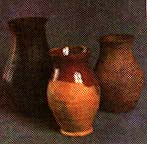 The three harlachs are made by means
of charna-hliancavanaia, palivanaia (partially) and hartavanaia techniques (left to
right)..
The three harlachs are made by means
of charna-hliancavanaia, palivanaia (partially) and hartavanaia techniques (left to
right)..
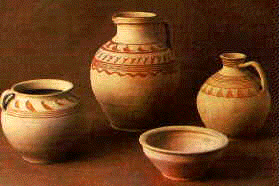 "Haradnianskaya"
- ceramics from Haradnaia village, Stolin region. Left to right are: zban, harliak, miska
and hliak.
"Haradnianskaya"
- ceramics from Haradnaia village, Stolin region. Left to right are: zban, harliak, miska
and hliak.
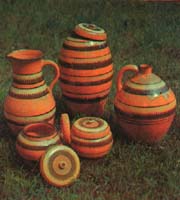 "Fliandravanaia" ceramics is the second most common type of
ceramics in Belarus. This fliandravanaia ceramics was made in the village of Ivianec,
Valozhyn region. "Fliandrouka" is the method when the fresh paint on the surface
of the vessel is turned into periodic parallel lines or zigzag ornaments with a comb.
Depicted are three zbans (left) and hliak (right). The glossy coating is made by
"palivanaia" method.
"Fliandravanaia" ceramics is the second most common type of
ceramics in Belarus. This fliandravanaia ceramics was made in the village of Ivianec,
Valozhyn region. "Fliandrouka" is the method when the fresh paint on the surface
of the vessel is turned into periodic parallel lines or zigzag ornaments with a comb.
Depicted are three zbans (left) and hliak (right). The glossy coating is made by
"palivanaia" method.
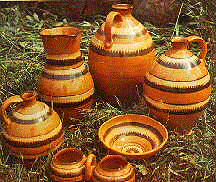 Another sample of ceramics from Ivianets, Valozhyn region. It is sometimes called "Ivianeckaia"
ceramics. Left to right front row: two small harshoks and miska; back row hliak, zban and
two more hliaks.
Another sample of ceramics from Ivianets, Valozhyn region. It is sometimes called "Ivianeckaia"
ceramics. Left to right front row: two small harshoks and miska; back row hliak, zban and
two more hliaks.
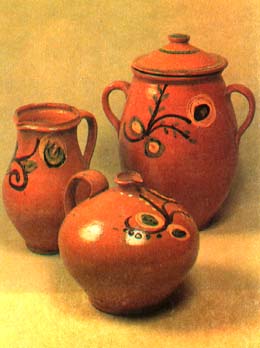 "Rakauskaia"
"Rakauskaia"
- ceramics from Rakau, Valozhyn region. THe shapes of the vessels were very specialized. Here we see "Zban", "hliak" and "sloik". They were used for milk, water and making cream, respectively.
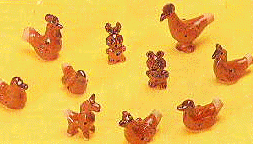 Clay toys (Bel.:"cacki") and especially toy-whistles (Bel.:"svisciolki"),
are rather usual things for kids in Belarus even nowadays. Although plastics are recently
often replacing ceramics :-( They can come in all methods and styles that are
characteristic to each of the regions.
Clay toys (Bel.:"cacki") and especially toy-whistles (Bel.:"svisciolki"),
are rather usual things for kids in Belarus even nowadays. Although plastics are recently
often replacing ceramics :-( They can come in all methods and styles that are
characteristic to each of the regions.
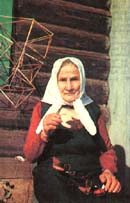 One of the craftsmanship "magicians" - master P. Shmatko is making her toys
for another generation of Belarusian children.
One of the craftsmanship "magicians" - master P. Shmatko is making her toys
for another generation of Belarusian children.
You can try to acquire some of Belarusian ceramics through a highly acclaimed in Belarus Gallery "U Majstra" in Hrodna. I've been there myself. It's a great place. They have some Belarusian folk art - straw figures, wooden sculptures, ceramics, etc.
References used:
Sahuta Ja.M. "Narodnaje mastactva Belarusi" ("Folk Art of
Belarus")
Publishing house "Bielaruskaja Encyklapiedyja" named after Piatrus' Brouka,
Minsk, 1997- 287 pages.
ISBN 985-11-0075-7
"Etnahrafiia Belarusi" Encyclopedia ("Ethnography of
Belarus")
Publishing house "Belarusian Soviet Encyklapiedyja" named after Piatrus' Brouka,
Minsk, 1989.
575 pages.
ISBN 5-85700-014-9
 This file is a part of
the Virtual Guide to Belarus - a collaborative project
of Belarusian scientists and professionals
abroad. VG brings you the most extensive compilation of the information about Belarus on
the Web. Please send your comments to the authors of VG to
Belarus
This file is a part of
the Virtual Guide to Belarus - a collaborative project
of Belarusian scientists and professionals
abroad. VG brings you the most extensive compilation of the information about Belarus on
the Web. Please send your comments to the authors of VG to
Belarus
History | Statehood | Culture | Law and
Politics | Cities | Nature and Geography |